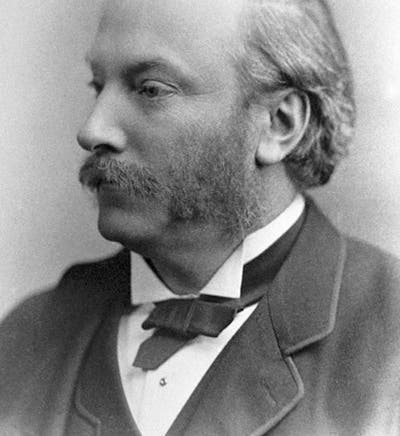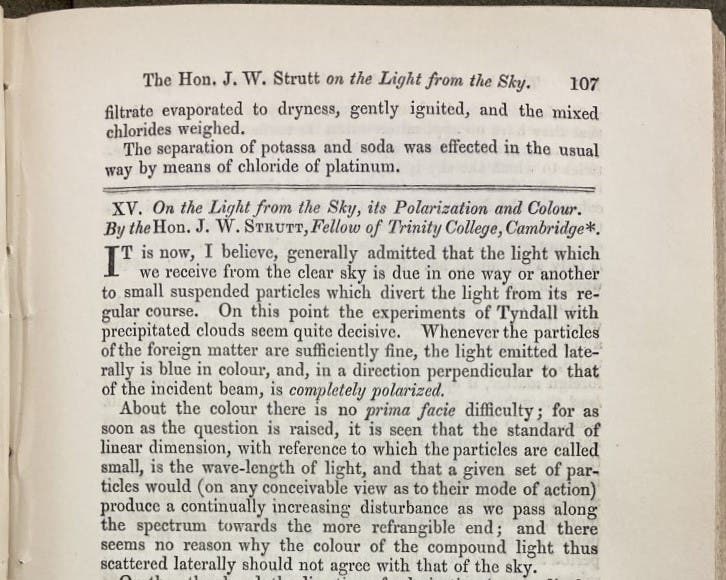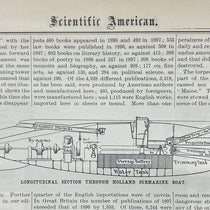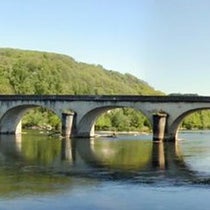Scientist of the Day - Lord Rayleigh
John William Strutt, 3rd Baron Rayleigh, was born Nov. 12, 1842. Strutt was almost always referred to as Lord Rayleigh in scientific publications, and we will do so here. Rayleigh was considered by many late Victorian scientists to be the heir of James Clerk Maxwell and the equal of Lord Kelvin at Glasgow and Hermann Helmholtz in Germany. Rayleigh published an enormous number of papers on nearly every branch of physics over the course of a fifty-year career. He is best known for an early paper in which he derived an equation for scattering in the atmosphere that showed why the sky is blue, and for discovering a new element, argon, in 1894. Before discussing the argon affair, we show a detail of the first page of his article, “On the nature of light from the sky, its polarization and color,” which appeared in the London, Edinburgh and Dublin Philosophical Magazine in 1871 (second image, below).
Rayleigh’s isolation of argon proceeded from his discovery, in 1892, that nitrogen derived from ammonia is about 0.5 percent less dense than nitrogen taken from the atmosphere, suggesting that atmospheric nitrogen has something else in it. Using a technique introduced by Henry Cavendish a full century earlier, Rayleigh sent sparks through atmospheric nitrogen, which oxidized it, and he slowly zeroed in on the residue that refused to be oxidized, which turned out to be a new element, indeed, a new kind of element, the first of the so-called noble or inert gases. As it happened, Rayleigh had publicly announced the anomaly (the 0.5 percent discrepancy) in 1892, and the problem was taken up by an English chemist, William Ramsay, with or without the permission (we are not sure) of Rayleigh. The two quests, one physical, one chemical, were successful almost simultaneously, in August of 1894, and the two men announced the discovery of argon in a joint paper in January of 1895 (third image, below).
There was some resistance by colleagues to the claim that this was a new element, since it would not fit into the periodic table of Mendeleev, but when Ramsay discovered helium a few months later, which was a similar inert gas, it was evident that an entirely new column needed to be added to the periodic table to accommodate the new gases. Rayleigh would receive the Nobel Prize in Physics in 1904 for the discovery of argon, and Ramsay would be awarded the Nobel Prize in Chemistry in the same year for the same discovery.
In spite of his achievements and his fame, Rayleigh’s life and career was quite different form that of Kelvin or Maxwell or even Ramsay. He did most of his work at the family estate at Terling Place in Essex (fifth image), where he had a wing built with a completely equipped laboratory, a room of which we see below (sixth image). He did agree to succeed Maxwell at Cambridge when Maxwell died in 1879, but Rayleigh was only an average teacher, and five years later, he resigned and moved back to Terling, remaining there for the rest of his life, except for an annual trip to fulfill duties at the Royal Institution in London.
Rayleigh did excellent work in his home lab, but the fact is that, after 1895, he was a classical physicist at a time when classical physics was being ushered out the door by quantum mechanics and relativity. Other older classical physicists like J.J. Thompson were able to make the transition, but Rayleigh could not. He and James Jeans published a paper on black-body radiation in 1900 that worked very well for long-wave radiation but not at all for short-wave (ultraviolet) radiation. That same year Max Planck explained the so-called ultraviolet catastrophe with a proposal that energy is quantized and is not infinitely divisible. Rayleigh could not accept the new quantum theory then, and never did. Michelson and Morley showed in 1887 that the so-called luminiferous ether could not be detected, and Rayleigh could not accept this either. He could not accept Einstein’s theory of special relativity, and he could not accept Niels Bohr’s proposal in 1913 that energy levels in the hydrogen atom are quantized, even though the assumption explained for the first time why hydrogen atoms emit only specific wave lengths of light.
One should not hold his resistance to the new physics against him. Had Rayleigh died in 1900, he would have been unable to receive the Nobel Prize, but otherwise his reputation would have been extremely distinguished, ranked with Maxwell and Kelvin with no qualifications. Still, Rayleigh’s later career does show how important younger scientists are to any scientific revolution, willing and even eager to discard the past and embrace what is often still inexplicable. Probably if Rayleigh had been born 30 years later, he would have been right up front with them.
Dr. William B. Ashworth, Jr., Consultant for the History of Science, Linda Hall Library and Associate Professor emeritus, Department of History, University of Missouri-Kansas City. Comments or corrections are welcome; please direct to ashworthw@umkc.edu.











